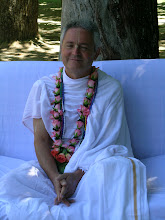This part of the Shrimad Bhagavatam could be defined: “The allegory of death”. Whatever Markandeya rishi witnesses in the macrocosm, I believe it is not different from all that each of us will witness at the moment of dissolution, of the microcosm of our body because, as it is explained in the Upanishad, macrocosm and microcosm are one the reflection of the other.
At the time of death, we will be carried away like a floating leaf into space and, in a second, under the influence of a powerful driving force, we will be projected out of the body.
Only through a spiritual realization we will be reminded of our origin, by understanding what is happening and acting in a sensible manner.
Markandeya rishi’s tale is the story of a realized soul who through the passage beyond death meets the Lord. In the ocean of universal devastation, the Lord appears to him as a toddler who floats on a leaf and sucks his big toe in tenderness, whilst the light that emanates from his body entirely disperses darkness.
Markandeya protects Him in his heart with deep devotion.
Today is His Holy Grace Bhaktisiddhanta Sarasvati's anniversary. I remember one of Shrila Prabhupada’s lessons held in this occasion in order to glorify his Master for the great work made to value the Vaishnava image and that one of an authentic Brahmin. During this lesson Shrila Prabhupada narrates the story taken from the Shrimad Bhagavatam. Naradamuni meets the sons of a Brahmin, of a king and of a butcher. Each of them asks him in turn: “Tell me what my future will be like. Is it better for me to live or to die?”. Narada answers to the Brahmin’s son: “Living or dying does not matter to you because you are practising spiritual activities and you will do the same after death”. Narada’s answer to the prince is: “It is better for you to live because you have made so many sins, therefore having ceased the pleasures of this life, you will have to suffer a great deal in your next life”. What is the answer to the butcher’s son? Narada says: “Living or dying is the same for you. You are suffering in this life and likewise you will suffer after death".





